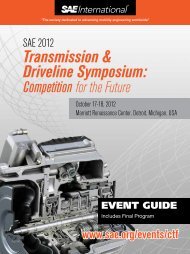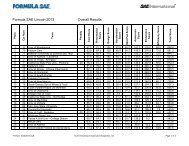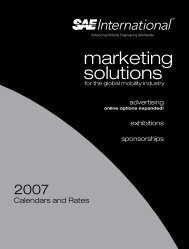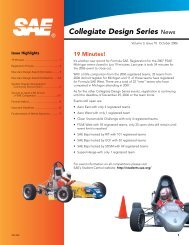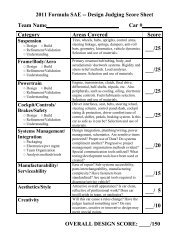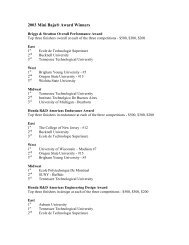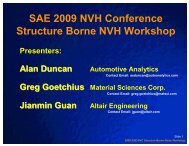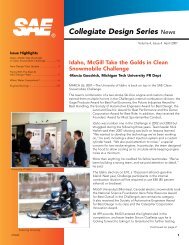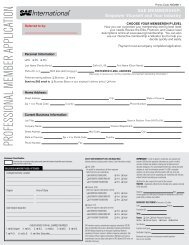SAE 2012 World Congress & Exhibition
SAE 2012 World Congress & Exhibition
SAE 2012 World Congress & Exhibition
Create successful ePaper yourself
Turn your PDF publications into a flip-book with our unique Google optimized e-Paper software.
Automotive Active Safety Systems help prevent accidents or mitigate accident severity. Some active safety systems provide warnings to the driver in<br />
critical situations, while other systems respond to threats by automatically braking and steering the vehicle. Active Safety systems are enabled by onboard<br />
sensors, together with environmental sensors such as radars and cameras. In the future, car-to-car and car-to-infrastructure communication<br />
will enhance system functionality and performance.<br />
Organizers -<br />
Chairpersons -<br />
Active Safety (Part 2 of 2)<br />
Session Code: AC600<br />
Room D3-21<br />
Joseph Kanianthra; Walter Kosiak, Delphi Corp.<br />
Walter Kosiak, Delphi Corp.<br />
Time Paper No. Title<br />
8:00 a.m.<br />
8:20 a.m.<br />
8:40 a.m.<br />
9:00 a.m.<br />
9:20 a.m.<br />
9:40 a.m.<br />
10:00 a.m.<br />
10:20 a.m.<br />
<strong>2012</strong>-01-0289<br />
<strong>2012</strong>-01-0288<br />
<strong>2012</strong>-01-0282<br />
<strong>2012</strong>-01-0281<br />
<strong>2012</strong>-01-0287<br />
<strong>2012</strong>-01-0291<br />
<strong>2012</strong>-01-0284<br />
Benefit Estimation of a Lane Departure Warning System using<br />
ASSTREET<br />
Towards ¿Vision Zero¿<br />
The Relationship between Driver Acceptance and System Effectiveness<br />
in Car-Based Collision Warning Systems: Evidence of an Overreliance<br />
Effect in Older Drivers?<br />
Development of a Coordinated Strategy of Steering Torque Overlay and<br />
Differential Braking for Unintended Lane Departure Avoidance<br />
Networking Break<br />
Efficacy and Usage Patterns for Three Types of Rearview Camera<br />
Displays During Backing Up<br />
Extension of the Honda-DRI ¿Safety Impact Methodology¿ (SIM) for the<br />
NHTSA Advanced Crash Avoidance Technology (ACAT) II Program and<br />
Application to the Evaluation of a Pre-Production Head-On Crash<br />
Avoidance Assist System - Progress Report<br />
Field Relevance of the New Car Assessment Program Lane Departure<br />
Warning Confirmation Test<br />
The papers in this session are available in <strong>SAE</strong> Technical Paper Collection, COLL-TP-00242, and also individually. To<br />
purchase visit collections.sae.org<br />
Planned by Automobile Chassis Activity / EMB Land and Sea Group<br />
Shin Tanaka, Tsutomu Mochida, Toyota Motor Corporation; Masami Aga,<br />
Toyota Motor North America, Inc.; Jun Tajima, Advanced Solutions<br />
Technology JAPAN<br />
Alexander E. Schanz, Reinhold Hamann, Robert Bosch GmbH<br />
Scott Stevens, Volpe Center, U.S. DOT<br />
Junyung Lee, Kyongsu Yi, Seoul National Univ<br />
Robyn Kim, Robert Rauschenberger, Genevieve Heckman, Doug Young,<br />
Robert Lange, Exponent, Inc.<br />
John Zellner, Michael Van Auken, Jordan Silberling, Joseph Kelly, Brad<br />
Hagoski, Dynamic Research Inc; Yoichi Sugimoto, Yoshihiro Urai, Honda<br />
R&D Co Ltd<br />
Kristofer D. Kusano, Hampton C. Gabler, Virginia Tech<br />
Wednesday, April 25<br />
Session Time:<br />
1:00 p.m.<br />
Automotive Active Safety Systems help prevent accidents or mitigate accident severity. Some active safety systems provide warnings to the driver in<br />
critical situations, while other systems respond to threats by automatically braking and steering the vehicle. Active Safety systems are enabled by onboard<br />
sensors, together with environmental sensors such as radars and cameras. In the future, car-to-car and car-to-infrastructure communication<br />
will enhance system functionality and performance.



